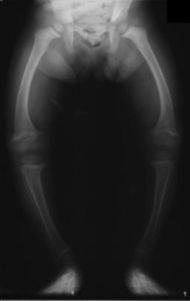Osteomalacia
2007 Schools Wikipedia Selection. Related subjects: Health and medicine
| X-ray of the legs in a two-year-old child with rickets. | |
| ICD- 10 | E 55.0 E 83.3 M 83. |
| ICD- 9 | 268.2 275.3 |
| DiseasesDB | 9351 |
| eMedicine | ped/2014 radio/610 |
| MeSH | D010018 |
Osteomalacia ( pronounced /ˌɑstioməˈleɪʃiə/) is the adult equivalent of the disease rickets. Osteomalacia denotes those disorders where mineralisation of newly formed bone matrix is defective.
Causes
- Nutritional inadequacy of Vitamin-D, calcium, or both
- Renal tubular defects that produce hypophosphatemia and chronic metabolic acidosis
- Chronic administration of diphenylhydantoin leading to excessive metabolism of Vitamin D
- Osteoporosis
- Following a parathyrodectomy
Clinical features
Osteomalacia starts as aches and pains insidiously, in lumbar spine and thighs spreading later to arms and ribs. Pain is non-radiating symmetrical and accompanied by tenderness in the involved bones. Proximal muscles are weak and there is difficulty in climbing upstairs and getting up from squatting position. Physical signs include deformities like triradiate pelvis and spinal kyphosis. Pathologic fractures due to weight bearing may develop. Biochemical features are similar to rickets.jklj;jkl; Radiological feature is characterised by appearance of "pseudofractures"
Treatment
Nutritional osteomalacia responds well to administration of 2000-4000 IU of Vitamin D for 6-12 weeks, followed by a maintanence dose of 400-600 IU daily. Dietary supplimentation in the form of milk is recommended. Medicinal calcium in the form of calcium gluconate, lactate, or carbonate can be given.
